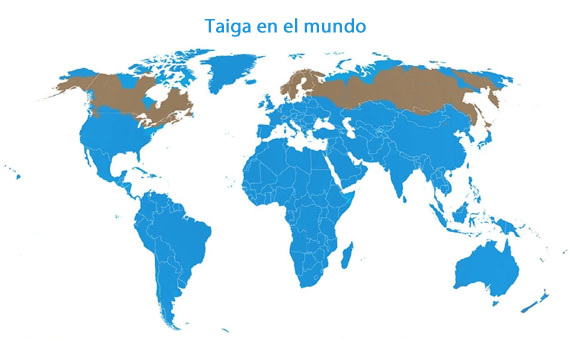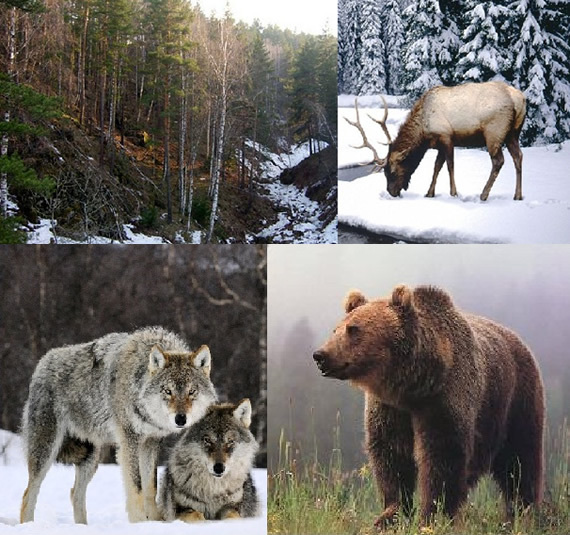Taiga Characteristics
Biology / / July 04, 2021
The taiga It is a type of forest formed by conifers, being a cold and uninhabited forest, this is advancing from the poles towards the equator, this is located after the tundra where the biome called taiga or forest appears Boreal. This biome is found mostly in the northern part of the continents, especially in Russia, northern Europe, Alaska, and Canada. In the southern hemisphere there is no taiga, since the humidity conditions are very different, which causes that in the similar latitudes of the southern hemisphere, there is a cold forest but it is not the taiga.
Characteristics of the biome called taiga:
Lighting characteristics
Being located in the extreme north of the continents, it has long days with short nights during the summer and long nights and days short during winter, due to its northern location (to the north). The warmer seasons with greater solar illumination are the summer months, and during this period of between 3 and 4 months, is when the conifers grow, stopping their growth in the months cold It is also the breeding period of the animals that inhabit the taiga.
In the southern hemisphere there is no taiga, since in the equivalent latitudes and climatic range, there is almost no land and due to the conditions of excess humidity and wind, in this area located in the south of America, the cold humid forest or subpolar forest develops Magellanic.
Weather
The climate of the taiga has an average temperature of 4 ° C, which ranges from -40 ° C during the winter to 18 ° C in the summer months. They are areas with little rainfall, reaching an average of between 450 mm and 700 mm of rain per year. Despite the low humidity, the soil does not dry out, due to the fact that in this biome there is little evaporation and a large amount of water produced by the thaws of the glaciations. Unlike the tundra, in which the permafrost predominates, frozen soil in deep layers, in the taiga only the most superficial layer of the soil remains cold; However, this superficial layer limits the decomposition of the litter, which is why it is present practically without decomposing and the soil is poor in nutrients.

Life adaptations
In these conditions of climate and humidity, there are very few animals, and the main life forms are made up of conifers. The animals have developed thick coats and layers of fat under the skin that allow them to withstand low temperatures. Regarding plant life, conifers predominate in these forests, which have adapted to nutrient-poor soil, the water is absorbed from the unfrozen layers deeper in the earth, and some nutrients are obtained through the action of fungi, since there is almost no bacterial activity that returns the nutrients to the I usually.
Flora
Coniferous trees predominate in the taiga: pines, firs, elms, cypresses, maples, pines and oaks, which can reach up to 40 meters in height. A characteristic of these trees are their needle-like leaves, elongated and rounded leaves, woody, and covered with a waxy layer, which allows them to retain water; the sap of these trees is rich in sugars, to avoid freezing during the summer. There are also smaller shrubs, such as rose bushes, blueberries, and blackberries, generally located near rivers. In this biome grasses do not grow, the undecomposed leaf litter of the trees covers the ground, and among it some grow lichens and fungi, which allow some nutrients to return to the soil and can be absorbed again by the trees. There are also lichens that grow on the bark of trees to reach sunlight.
Fauna

The fauna of the taigas is not very diverse. Among herbivores, large species such as elk, deer and reindeer can be found, as well as small species: mice, squirrels, rabbits and hares. Among the predators, which also have thick coats, are the wolf, lynx, weasels, minks and martens. In these forests there are also bears and raptors such as owls. During the summer time insects and worms are also found. These insects and worms, as well as bears and other mammals, hibernate during the colder months, and are most active during the summer. Others, like squirrels, save food for the dry winter months.
The swamps
A characteristic landscape of the taigas and boreal forests, are the swamps, lakes formed by the melting of ice ages, Within these lakes, leaf litter, pine cones, branches and other detritus fall from the trees, which are deposited in layers during the year. As the climate is so cold, there are not even bacteria that decompose all that sediment, there are accumulated plant remains. This means that in many cases the banks of the swamps become land on which some bushes and new trees grow, they remain in the middle, areas where there is only water. However, in other cases, the swamps spread through the forest. The sediments of the swamps are the source of much knowledge about the formation and evolution processes of these forests.
Characteristics of the types of taiga:
Russian Taiga - Scandinavian
Located throughout the European and Asian continent, the Taiga, which in Russian means “thick forest”, is characterized by forming a continuous zone, within the so-called Paleo-arctic ecozone. This belt of tundra extends from the shores of the Pacific Ocean in Russia, in the regions of Kamskatka and Siberia, to the regions closer to Europe such as Smolenk and Psov, and forming a continuity with most of the territories of Norway, Sweden and Finland. The taiga is characterized by the presence of Siberian pines, firs and larch, and as it approaches Europe, juniper and Norway spruce, birch and white birch are added. Regarding the fauna, we find white and brown bears, martens, stoats, elk, white owls, mice and squirrels.
American boreal forest
The American taiga or American boreal forest is the strip in the northern hemisphere that covers most of the territories of Canada and Alaska. Pine, cedars and maples abound in these forests, as the main species of conifers, as well as lichens that grow on the ground. Regarding the fauna, there are bears, mainly brown and black, wolves, coyotes, pumas, among the predators, and antelope, reindeer, elk, beaver, porcupine, mole, and other rodents among the herbivores.
Magellan subpolar forest
Although this ecosystem does not belong to the taiga itself, it shares the same latitude and temperature zone as the taiga, but with certain peculiarities. It is found in the southernmost region of the former mountain range, encompassing an area of Tierra del Fuego in Chile and Argentina. It is located in the same temperature zone of the taiga, with an average temperature of 3 ° to 6 ° C. The peculiarity of this climate is that it is very humid, with rainfall of up to 5000 mm per year. Among the flora, there are species of beech trees, such as the coigüe, the ñirre and the lenga, as well as the notro. Another characteristic is that it is a region of strong winds, both from the Atlantic and the Pacific, which shapes the configuration of the trees. Among the fauna are the Pud, the smallest species of deer, otters, the Patagonian rat, mole mouse, the vizcacha, among rodents, otters, punas, woodpeckers and condors.

